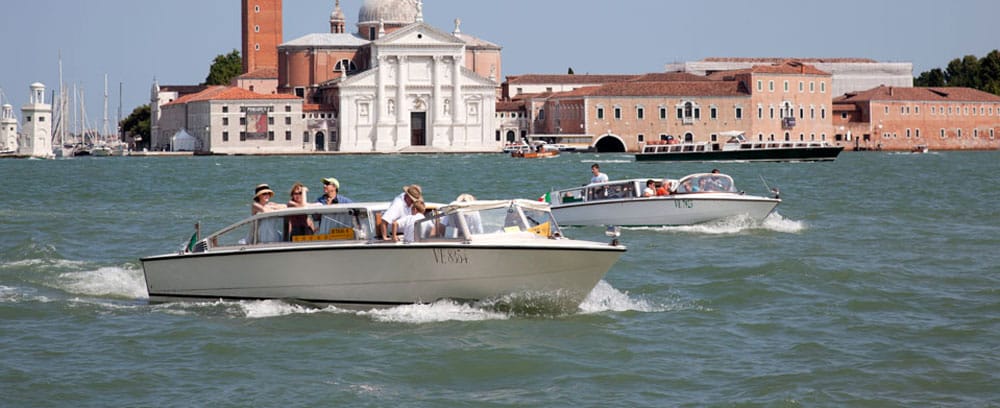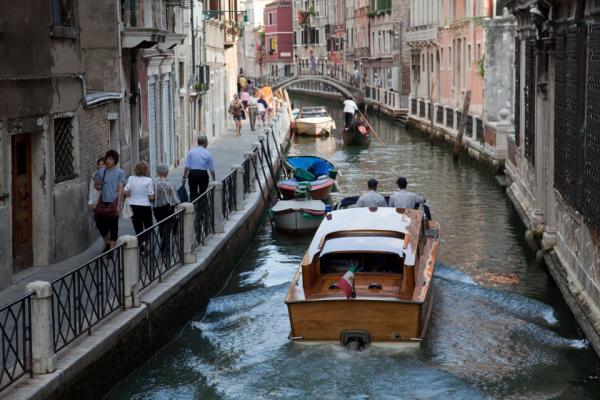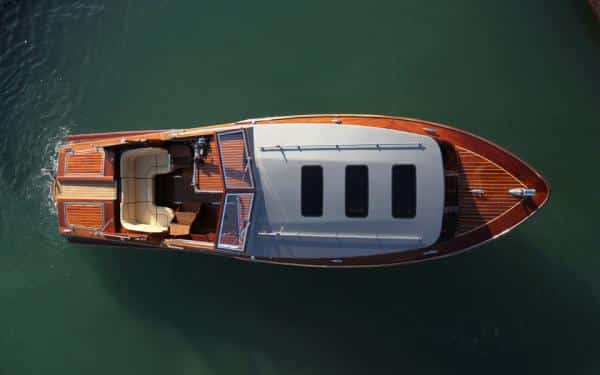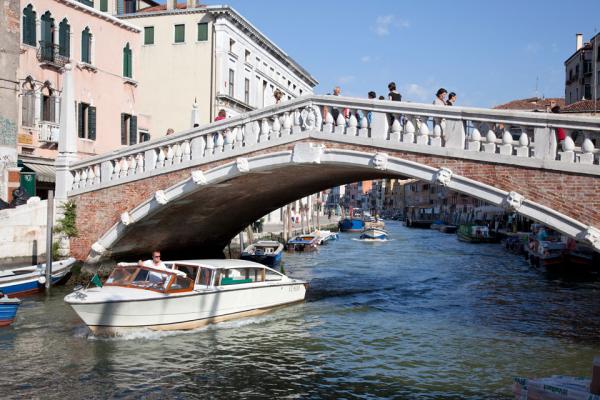
Venice Water Taxi
It’s hard to think of a place with quite so much waterborne traffic as Venice, Italy. Besides the ferries, or vaporetti, and commercial barges, or topi (meaning water rats), the police, ambulance and fire services — not to mention the traffic cops — also get around by boat. Although the gondola might be the most iconic Venetian watercraft, it is now a touristic curiosity from the days when aristocratic families vied for the most ornate personal transport. With the invention of the internal-combustion engine, traditional gondolas were superseded by elegant motorized runabouts, which developed into the motoscafi, Venice’s water taxis (see the complete photo gallery here).
My visit to Venice during the Festa del Redentore reminded me of just how central the canal system is to the city’s way of life. This festival takes place each June to celebrate the end of the plague in 1576. The highlight of the festival is a truly impressive fireworks display, and preparations begin early in the morning when Venetians start decorating their boats. At sunset, the St. Mark’s basin in front of the famous square begins to fill up with small boats of every conceivable kind, festooned with bunting and balloons, all jostling for the best positions, while thousands of Venetians await the fireworks with picnic dinners on their boats, accompanied by a bottle of wine — or two.
I was lucky enough to be in a prime position to witness all this, aboard an open runabout owned by Andrea Tagliapietra, who manages the eponymous family-run boatyard, founded by his father in 1976 on the island of Giudecca in full view of St. Mark’s. Boatbuilding runs in the family, and his grandfather learned his trade at the historic Cantiere Navale Celli, constructing wooden mine sweepers and other fast craft (including Niniette, a motorboat powered by a 200-horsepower Bugatti engine that claimed a world record in 1931 with a speed of nearly 63 miles per hour). Today, the Tagliapietra yard, where Andrea started working at the age of 16 for his father, who still takes an active role at 69, is one of just a handful of yards remaining that specialize in building and restoring taxi-style launches.

“The original taxi boats were completely different from the ones we know today,” explained Andrea from his office above the yard, where sketches on his desk rested under a fine dusting of mahogany from the shop floor below. “The engine was mounted forward because of the need to accommodate a long drive shaft, and the driver was seated farther aft behind the big foredeck.” Indeed, below us sat just such a design built in 1983 — thought to be the last of its kind in Venice — now privately owned and awaiting restoration.
“The big change came with the invention of the Z-drive,” continued Andrea, “which eliminated the need for a conventional rudder and, more importantly, meant the engine could be mounted aft.” This technological advance was initially met with skepticism from taxi drivers because it meant higher maintenance costs, but the improved maneuverability was undeniable. The rear-mounted engine also meant the helm position could be pushed as far forward as possible — a vital consideration that aids sight lines when navigating the dogleg corners on some of Venice’s smaller canals.
“Another change was the introduction of fiberglass,” said Andrea, with some distaste. Like all traditional boatbuilders, Andrea has reservations about fiberglass — and not just for reasons of craftsmanship. The standard argument in favor of fiberglass is that maintenance is lower than for a wooden hull, but Andrea disagrees.
“The parts of the boat that deteriorate quickest are the mahogany topsides, as they are most exposed to the elements,” he explained. “Moreover, the wooden hulls were the result of a long process of evolution — one-offs that were modified each time to improve handling and performance. The fiberglass hulls, on the other hand, came from a common mold, so development was effectively stopped in its tracks. Most of the fiberglass taxis out there today have hull forms dating back to the ’80s or ’90s.”
Although the Tagliapietra yard does build in fiberglass off-site using the latest vacuum infusion methods, in order to maintain the development process it is experimenting with one-off hulls using both male and female polystyrene molds. But Andrea’s core values derive from the traditional boatbuilding techniques, using jigs and copper clinch nails, that he learned as a teenager.
“It’s a sublime process because no adhesives were involved,” he said while fingering an end planer made of South American guaiacum, or holy wood (so called because it is thought the Holy Cross was made of the same wood), engraved with his grandfather’s initials. “Instead, an intermediate layer of canvas soaked in linseed oil was used for waterproofing the hull. But for new wooden builds we use the cold-molding process with a base layer of strip planking followed by multiple veneers oriented in different directions for a light yet strong monocoque structure.”

Although the modern Venice water taxi used for public transport is not the work of a single designer or naval architect, its design has been standardized as a result of local government legislation. The length overall is just over 29 feet with a beam of around 7 feet, and it can carry no more than 12 passengers. The diesel power plants are limited to 150 horsepower — the maximum speed limit within the city’s historic center is about 3 miles per hour (and, yes, the traffic cops do use radar guns!). The height of the coachroof above the waterline is determined by the lowest bridges — a feature that has proved useful for the taxi boat’s current revival as a superyacht tender where garage height is limited. Because of the increasing volume of traffic on the canals, several years ago the local authorities funded research into a mini taxi of approximately 30 feet in length; a fiberglass prototype was built but the concept never took off.
The modern electronic engines are supplied by all the primary manufacturers, who use Venice as a proving ground because of the punishing daily schedule of most taxis. Marco Ferialdi, for example, a 24-year-old driver whose Venice water taxi is almost as old as he is, will commonly work a 10-hour day. A short city tour with the young driver revealed the constant maneuvering and evasive action required to avoid other traffic in the narrow canals, especially the gondolas, which have right of way. With some of these canals operating a one-way system that changes direction during the day depending on the tidal currents, driving a taxi in downtown Manhattan is child’s play in comparison. Like their land-based counterparts, however, taxi licenses are a precious commodity and limited to just 300 in total (including public taxis and those for private hire, identified by a yellow or green banner, respectively). With almost 100,000 miles on the clock, Ferialdi’s taxi has already gone through five engines, and the boat is overhauled at least four times a year and has a monthlong stay in dry dock during the winter.
A heavy rub rail that forms a structural element of the hull is an essential design feature, which reflects the battering that taxis undergo during the course of their working day. To withstand the constant knocking the boats suffer even when tied up between wooden mooring posts, at the Tagliapietra yard this rail (appropriately called a dormiente, the Italian word for sleeper) is made of 1.18-inch solid mahogany topped with a stainless-steel strip. Despite this, Andrea showed me one boat undergoing restoration with a rail that had been worn down in places through steel and mahogany to the bare hull.
A short boat trip from Giudecca on the island of Murano, famous for its glassware, is the historic Cantiere Motonautico Serenella. I was shown around the yard by Andrea Pagiaro, a taxi driver and boatbuilder of 25 years’ experience. Three new cold-molded Venice water taxi boats were being built beside a number of maintenance projects, including a runabout christened Serenella Express that took part in the 1992 Venice-Monte Carlo offshore race. Pagiaro explained that a standard taxi boat can take up to 3,000 man-hours to build from concept to completion, and a limousine superyacht tender can take much longer. Carefully stacked outside with spacers between each plank to facilitate airing were several tons of African mahogany. After being left for two years to dry out, the wood that has escaped cracking is considered ready to use, although it is customary to put aside a few yards of the same plank to book-match the grain if repairs are required later.

Superbly conceived to perform its specific function as a stylish people carrier, there is no doubt that the water taxi has inspired other boat designs, especially in the superyacht field. Jon Bannenberg drew on its timeless lines when he commissioned Vikal International in Western Australia to produce the premier yard’s very first limousine tenders for Lürssen Yachts’ Coral Island back in the early ’90s. The Serenella yard has also delivered several such craft, one of the most recent being for the 239-foot Ilona IV (a personal thank-you letter from designer Justin Redman of Redman Whitely Dixon hangs in a frame on the office wall). Tagliapietra has built the waterborne equivalent of the “Popemobile” and luxury runabouts for Mr. Swarovski, who owns a Venetian island, and the Firestone family in California, which owns the Perini Navi ketch Tamsen. The yard’s custom tender for Issham Al Baher (see Custom Cabs_) — itself something of a historic yacht as the original _Atlantis, designed by Caesar Pinnau, who also drew _Christina O_ — is just the latest example of a design that owes its obvious good looks and discrete practicality to the enduring charm of the Venice water taxi.








